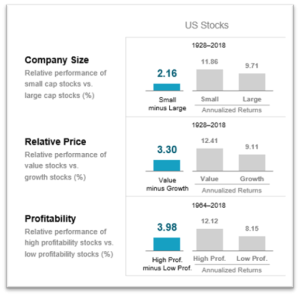In the past year, I started ordering fruits and vegetables from local farms, which provides my family with ultra-fresh foods and makes a lighter impact on the environment than my traditional grocery shopping. Consuming whole foods has made me prepare meals in a different way – I have to think about my meal plans ahead of time, and I end up cooking healthier and simpler meals with fewer ingredients. My search for simplicity in recipes has led me to notice it in other areas of my life as well. I notice that I need fewer outfits to wear to work and I put on less makeup. I have also found that simple portfolios can create positive outcomes for my clients.
I have talked with clients for years about the importance of diversification in portfolios. Put simply – a wise investment strategy is one that is spread out across the investment universe, or the old adage, “don’t put all your eggs in one basket”. The benefits of investment diversification are well documented so I will not be revisiting that today. I will be examining how best to get to that goal of good diversification – and how more isn’t always better. We can build a well-diversified portfolio by taking the conventional route (a bunch of investments in varying asset classes), or the simple route (factor based, fewer funds). Let’s consider each separately because, as with all things, there are pros and cons to each.
The Conventional Route:
In taking this path, an investor often picks a bunch of investments (usually mutual funds) that meet their target for diversification and risk. The resulting portfolio often holds 15 to 20 funds, but I’ve seen as many as 50. The logic here tends to be that because each fund is considered to be a superior performer in it’s own space, owning all of them will probably provide the best outcome.
A benefit of this strategy is that you end up owning a little bit of a lot of things. But this approach also ends up creating unneeded complexity and often higher than necessary expenses. We also know that this conventional route can create tax issues because of so many moving parts that are often unpredictable. Finally, historical evidence shows this management strategy to have a lower possible upside (aka returns).
The Simple Route:
In taking this path, the investor employs a philosophy that starts with simple market indices (the way an index fund does), and then adds extra focus on the four factors that have been academically proven to enhance returns: stock-forward investments, smaller sized companies, value-priced companies, and companies with high profitability (see image). This targeted process results in a portfolio that has just 8 to 12 mutual funds. The logic being that relying on superficial measures, like past performance, when building a portfolio is a futile effort. So, instead, the investor includes core index investments that get a boost from the four factors that drive better results over the long term.
Factor-based investing data¹ Benefits of this strategy include a streamlined approach and simplicity. Also, fewer funds tend to mean lower expenses much easier rebalancing. Historical evidence supports this route as providing a higher possible long-term upside. The drawback of this approach is that it’s not widely available to investors (yet). At this time, only a handful of fund companies have the technology and resources to implement this kind of investing and most of them only allow select institutions to have access for their clients.
Benefits of this strategy include a streamlined approach and simplicity. Also, fewer funds tend to mean lower expenses much easier rebalancing. Historical evidence supports this route as providing a higher possible long-term upside. The drawback of this approach is that it’s not widely available to investors (yet). At this time, only a handful of fund companies have the technology and resources to implement this kind of investing and most of them only allow select institutions to have access for their clients.
At ReFrame Wealth, we believe in taking the simple, direct route to portfolio management. We love academic data and appreciate the ability to keep things streamlined by incorporating that data. We know that keeping expenses low and staying the course matters, so we’ve built portfolios for our clients that make it easy to do both. Our portfolio managers have managed portfolios for 30 years and they espouse this management philosophy, maintaining portfolios that are straight and to the point – strong returns for our clients without added fillers.
¹Information provided by Dimensional Fund Advisors LP. All returns are in USD. Premiums are calculated as the difference in annualized returns between the two indices described over the period shown. MSCI indices are gross div. For US stocks, indices are used as follows. Small Cap minus Large Cap: Dimensional US Small Cap Index minus the S&P 500 Index. Value minus Growth: Fama/French US Value Research Index minus the Fama/French US Growth Research Index. High Prof minus Low Prof: Dimensional US High Profitability Index minus the Dimensional US Low Profitability Index. Profitability is measured as operating income before depreciation and amortization minus interest expense, scaled by book. Indices are not available for direct investment. Index returns are not representative of actual portfolios and do not reflect costs and fees associated with an actual investment. Past performance is no guarantee of future results. Actual returns may be lower. S&P data © 2019 S&P Dow Jones Indices LLC, a division of S&P Global. All rights reserved.
This content is developed from sources believed to be providing accurate information, and provided by ReFrame Wealth, LLC. It may not be used for the purpose of avoiding any federal tax penalties. Please consult legal or tax professionals for specific information regarding your individual situation. The opinions expressed and material provided are for general information and should not be considered a solicitation for the purchase or sale of any security.

